Edith Cowan University NUM1102 Communication: Interview Analysis Essay
VerifiedAdded on 2022/10/19
|11
|2338
|348
Essay
AI Summary
This essay provides a comprehensive analysis of a nursing interview, examining key elements of effective communication between a nurse and a patient. The analysis begins with an introduction to the importance of communication in healthcare, followed by a detailed discussion of questioning styles, including open-ended and closed-ended questions, and their impact on gathering patient information and building rapport. The essay then delves into the role of body language in the interview, highlighting the importance of non-verbal cues from both the nurse and the patient in establishing trust and understanding. Furthermore, the analysis explores the concept of empathy in nursing, emphasizing the nurse's ability to understand and share the feelings of the patient. The essay concludes by summarizing the key findings and reiterating the significance of effective communication, body language, and empathy in providing quality healthcare. References from various scholarly articles are also included.
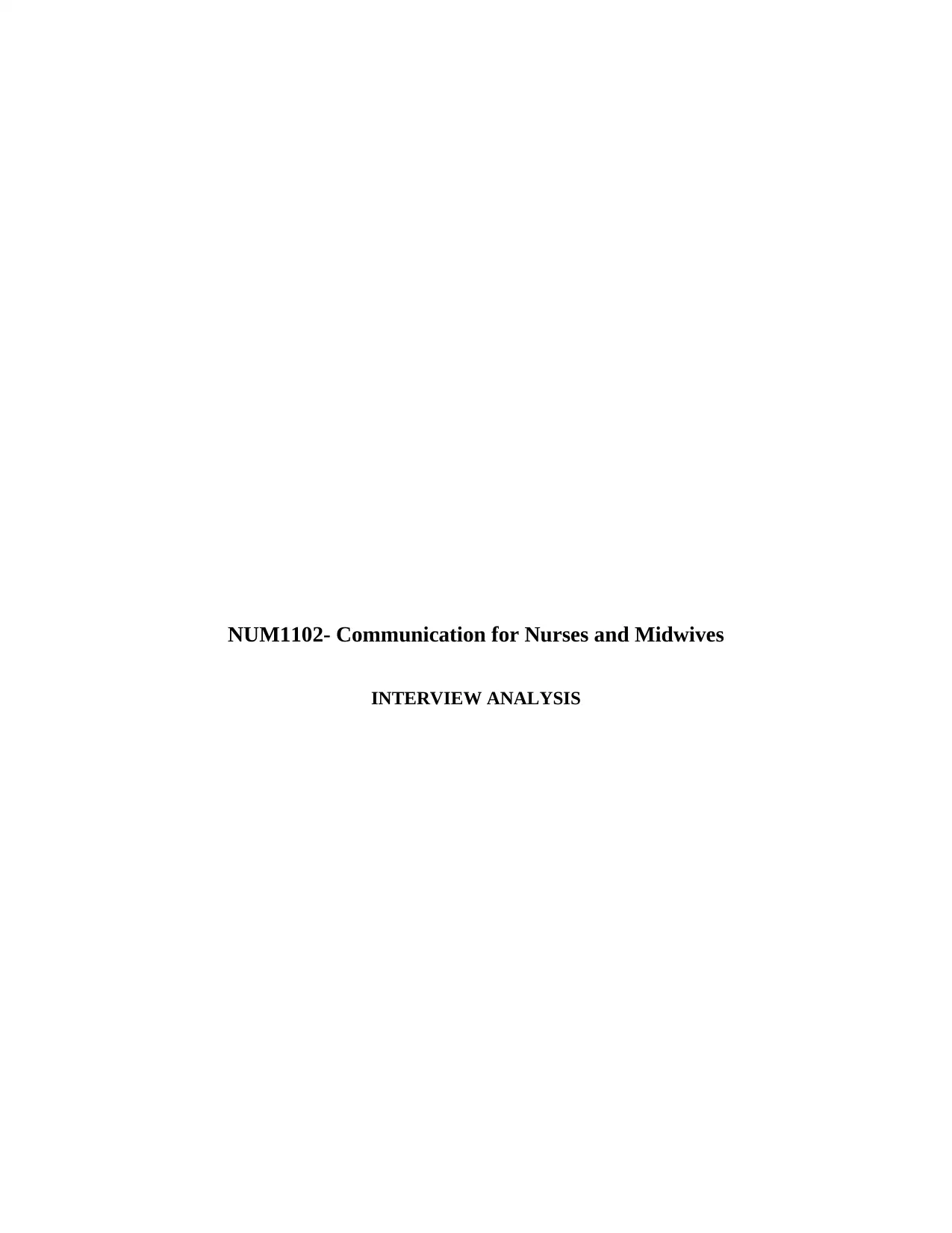
NUM1102- Communication for Nurses and Midwives
INTERVIEW ANALYSIS
INTERVIEW ANALYSIS
Paraphrase This Document
Need a fresh take? Get an instant paraphrase of this document with our AI Paraphraser
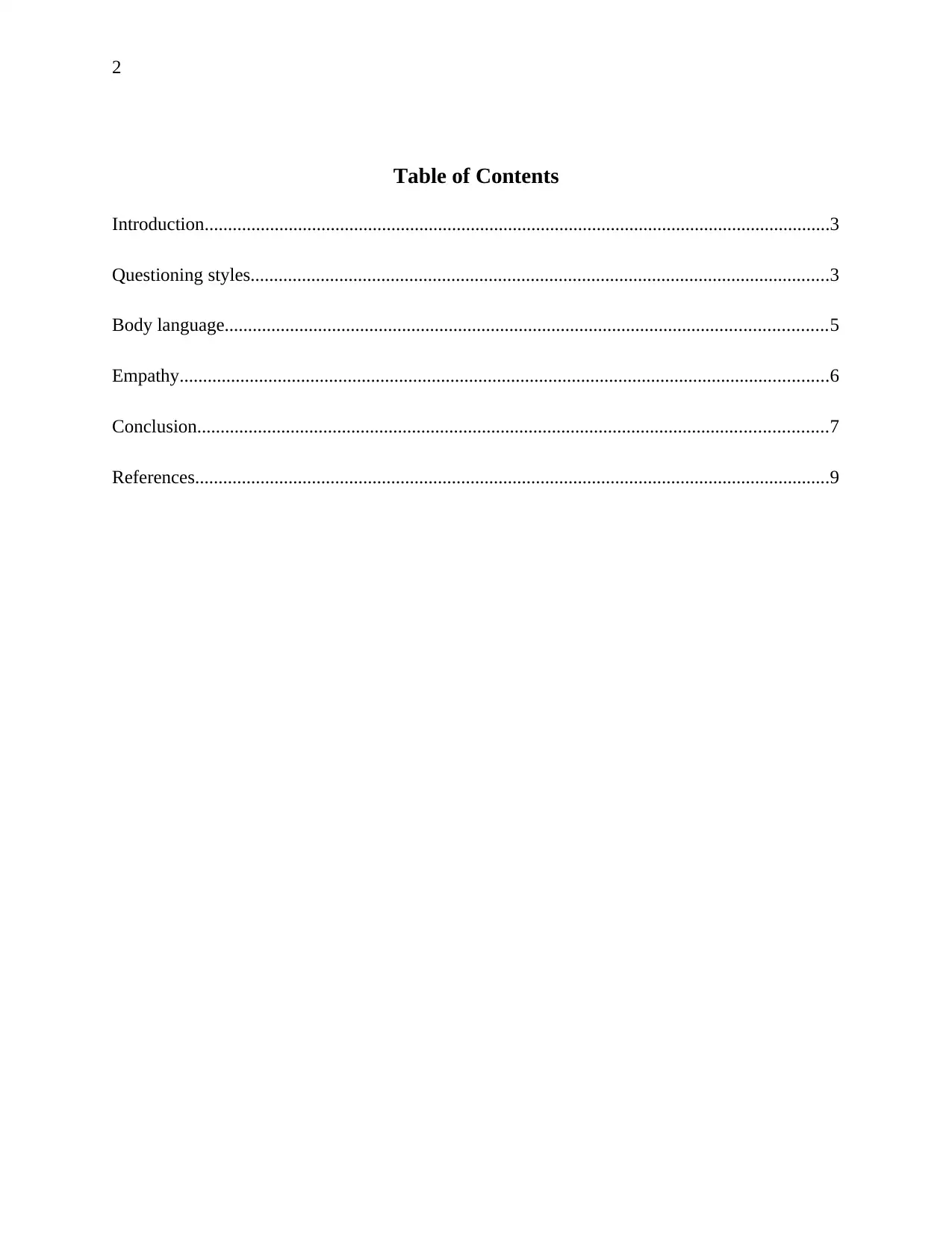
2
Table of Contents
Introduction......................................................................................................................................3
Questioning styles............................................................................................................................3
Body language.................................................................................................................................5
Empathy...........................................................................................................................................6
Conclusion.......................................................................................................................................7
References........................................................................................................................................9
Table of Contents
Introduction......................................................................................................................................3
Questioning styles............................................................................................................................3
Body language.................................................................................................................................5
Empathy...........................................................................................................................................6
Conclusion.......................................................................................................................................7
References........................................................................................................................................9
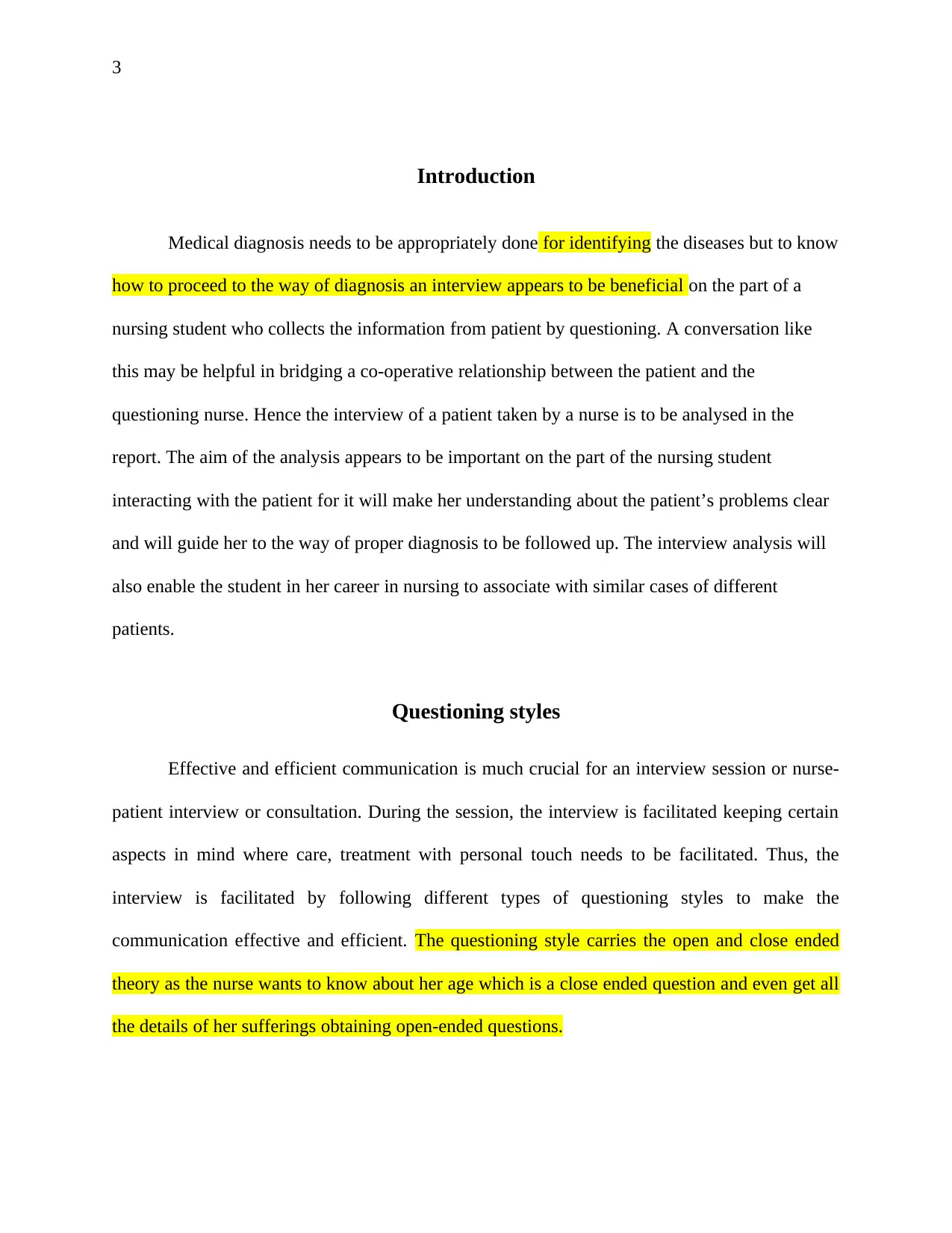
3
Introduction
Medical diagnosis needs to be appropriately done for identifying the diseases but to know
how to proceed to the way of diagnosis an interview appears to be beneficial on the part of a
nursing student who collects the information from patient by questioning. A conversation like
this may be helpful in bridging a co-operative relationship between the patient and the
questioning nurse. Hence the interview of a patient taken by a nurse is to be analysed in the
report. The aim of the analysis appears to be important on the part of the nursing student
interacting with the patient for it will make her understanding about the patient’s problems clear
and will guide her to the way of proper diagnosis to be followed up. The interview analysis will
also enable the student in her career in nursing to associate with similar cases of different
patients.
Questioning styles
Effective and efficient communication is much crucial for an interview session or nurse-
patient interview or consultation. During the session, the interview is facilitated keeping certain
aspects in mind where care, treatment with personal touch needs to be facilitated. Thus, the
interview is facilitated by following different types of questioning styles to make the
communication effective and efficient. The questioning style carries the open and close ended
theory as the nurse wants to know about her age which is a close ended question and even get all
the details of her sufferings obtaining open-ended questions.
Introduction
Medical diagnosis needs to be appropriately done for identifying the diseases but to know
how to proceed to the way of diagnosis an interview appears to be beneficial on the part of a
nursing student who collects the information from patient by questioning. A conversation like
this may be helpful in bridging a co-operative relationship between the patient and the
questioning nurse. Hence the interview of a patient taken by a nurse is to be analysed in the
report. The aim of the analysis appears to be important on the part of the nursing student
interacting with the patient for it will make her understanding about the patient’s problems clear
and will guide her to the way of proper diagnosis to be followed up. The interview analysis will
also enable the student in her career in nursing to associate with similar cases of different
patients.
Questioning styles
Effective and efficient communication is much crucial for an interview session or nurse-
patient interview or consultation. During the session, the interview is facilitated keeping certain
aspects in mind where care, treatment with personal touch needs to be facilitated. Thus, the
interview is facilitated by following different types of questioning styles to make the
communication effective and efficient. The questioning style carries the open and close ended
theory as the nurse wants to know about her age which is a close ended question and even get all
the details of her sufferings obtaining open-ended questions.
⊘ This is a preview!⊘
Do you want full access?
Subscribe today to unlock all pages.

Trusted by 1+ million students worldwide
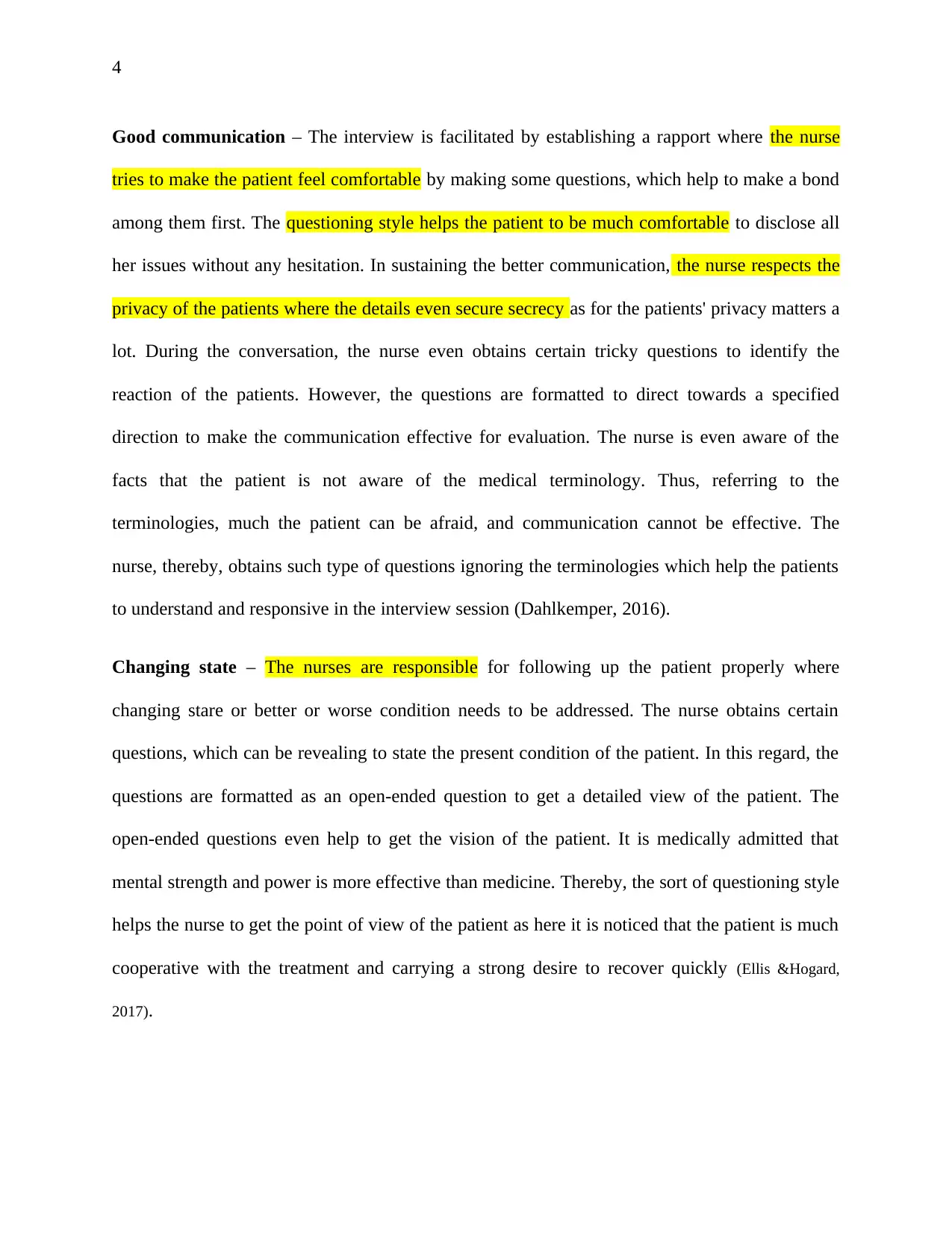
4
Good communication – The interview is facilitated by establishing a rapport where the nurse
tries to make the patient feel comfortable by making some questions, which help to make a bond
among them first. The questioning style helps the patient to be much comfortable to disclose all
her issues without any hesitation. In sustaining the better communication, the nurse respects the
privacy of the patients where the details even secure secrecy as for the patients' privacy matters a
lot. During the conversation, the nurse even obtains certain tricky questions to identify the
reaction of the patients. However, the questions are formatted to direct towards a specified
direction to make the communication effective for evaluation. The nurse is even aware of the
facts that the patient is not aware of the medical terminology. Thus, referring to the
terminologies, much the patient can be afraid, and communication cannot be effective. The
nurse, thereby, obtains such type of questions ignoring the terminologies which help the patients
to understand and responsive in the interview session (Dahlkemper, 2016).
Changing state – The nurses are responsible for following up the patient properly where
changing stare or better or worse condition needs to be addressed. The nurse obtains certain
questions, which can be revealing to state the present condition of the patient. In this regard, the
questions are formatted as an open-ended question to get a detailed view of the patient. The
open-ended questions even help to get the vision of the patient. It is medically admitted that
mental strength and power is more effective than medicine. Thereby, the sort of questioning style
helps the nurse to get the point of view of the patient as here it is noticed that the patient is much
cooperative with the treatment and carrying a strong desire to recover quickly (Ellis &Hogard,
2017).
Good communication – The interview is facilitated by establishing a rapport where the nurse
tries to make the patient feel comfortable by making some questions, which help to make a bond
among them first. The questioning style helps the patient to be much comfortable to disclose all
her issues without any hesitation. In sustaining the better communication, the nurse respects the
privacy of the patients where the details even secure secrecy as for the patients' privacy matters a
lot. During the conversation, the nurse even obtains certain tricky questions to identify the
reaction of the patients. However, the questions are formatted to direct towards a specified
direction to make the communication effective for evaluation. The nurse is even aware of the
facts that the patient is not aware of the medical terminology. Thus, referring to the
terminologies, much the patient can be afraid, and communication cannot be effective. The
nurse, thereby, obtains such type of questions ignoring the terminologies which help the patients
to understand and responsive in the interview session (Dahlkemper, 2016).
Changing state – The nurses are responsible for following up the patient properly where
changing stare or better or worse condition needs to be addressed. The nurse obtains certain
questions, which can be revealing to state the present condition of the patient. In this regard, the
questions are formatted as an open-ended question to get a detailed view of the patient. The
open-ended questions even help to get the vision of the patient. It is medically admitted that
mental strength and power is more effective than medicine. Thereby, the sort of questioning style
helps the nurse to get the point of view of the patient as here it is noticed that the patient is much
cooperative with the treatment and carrying a strong desire to recover quickly (Ellis &Hogard,
2017).
Paraphrase This Document
Need a fresh take? Get an instant paraphrase of this document with our AI Paraphraser
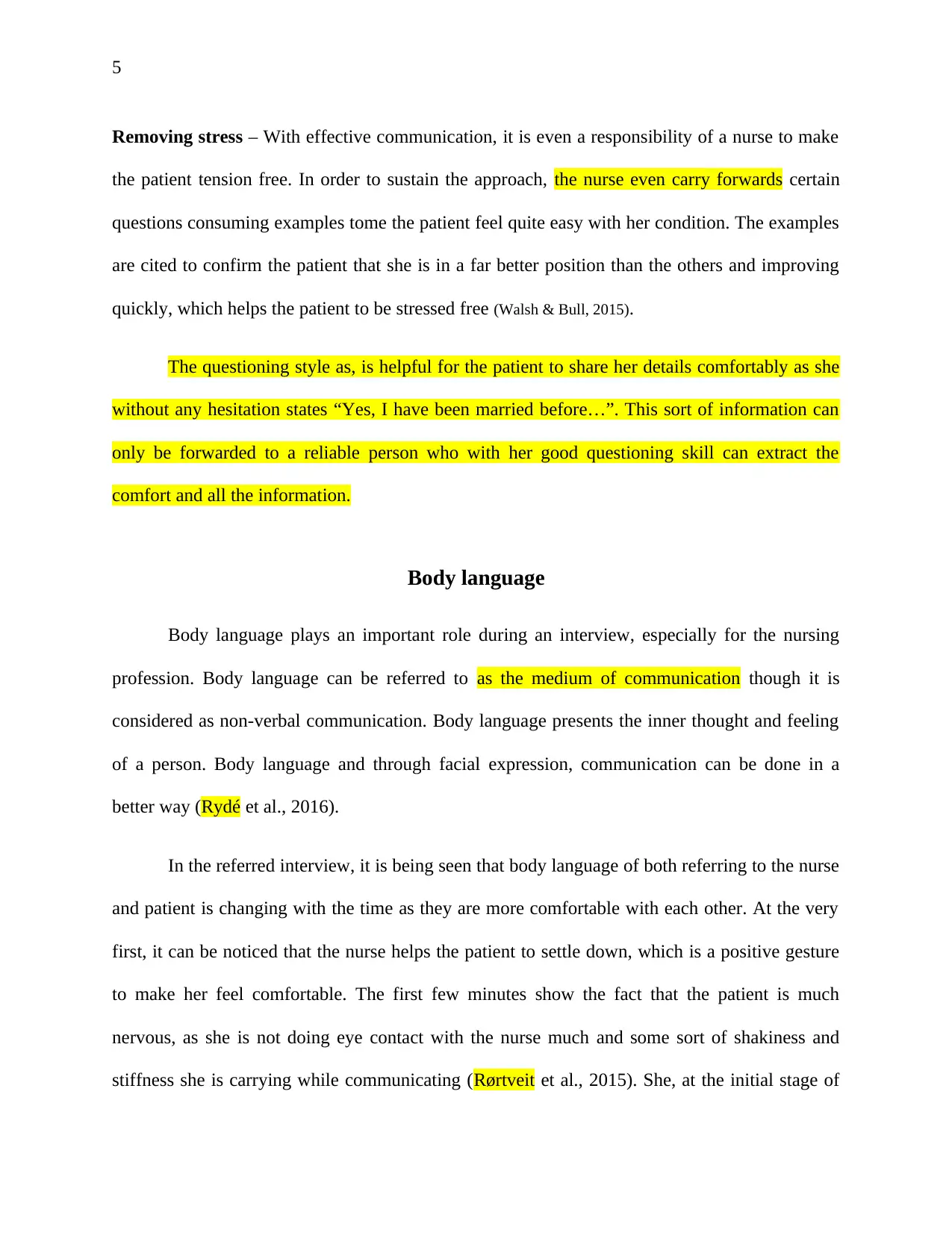
5
Removing stress – With effective communication, it is even a responsibility of a nurse to make
the patient tension free. In order to sustain the approach, the nurse even carry forwards certain
questions consuming examples tome the patient feel quite easy with her condition. The examples
are cited to confirm the patient that she is in a far better position than the others and improving
quickly, which helps the patient to be stressed free (Walsh & Bull, 2015).
The questioning style as, is helpful for the patient to share her details comfortably as she
without any hesitation states “Yes, I have been married before…”. This sort of information can
only be forwarded to a reliable person who with her good questioning skill can extract the
comfort and all the information.
Body language
Body language plays an important role during an interview, especially for the nursing
profession. Body language can be referred to as the medium of communication though it is
considered as non-verbal communication. Body language presents the inner thought and feeling
of a person. Body language and through facial expression, communication can be done in a
better way (Rydé et al., 2016).
In the referred interview, it is being seen that body language of both referring to the nurse
and patient is changing with the time as they are more comfortable with each other. At the very
first, it can be noticed that the nurse helps the patient to settle down, which is a positive gesture
to make her feel comfortable. The first few minutes show the fact that the patient is much
nervous, as she is not doing eye contact with the nurse much and some sort of shakiness and
stiffness she is carrying while communicating (Rørtveit et al., 2015). She, at the initial stage of
Removing stress – With effective communication, it is even a responsibility of a nurse to make
the patient tension free. In order to sustain the approach, the nurse even carry forwards certain
questions consuming examples tome the patient feel quite easy with her condition. The examples
are cited to confirm the patient that she is in a far better position than the others and improving
quickly, which helps the patient to be stressed free (Walsh & Bull, 2015).
The questioning style as, is helpful for the patient to share her details comfortably as she
without any hesitation states “Yes, I have been married before…”. This sort of information can
only be forwarded to a reliable person who with her good questioning skill can extract the
comfort and all the information.
Body language
Body language plays an important role during an interview, especially for the nursing
profession. Body language can be referred to as the medium of communication though it is
considered as non-verbal communication. Body language presents the inner thought and feeling
of a person. Body language and through facial expression, communication can be done in a
better way (Rydé et al., 2016).
In the referred interview, it is being seen that body language of both referring to the nurse
and patient is changing with the time as they are more comfortable with each other. At the very
first, it can be noticed that the nurse helps the patient to settle down, which is a positive gesture
to make her feel comfortable. The first few minutes show the fact that the patient is much
nervous, as she is not doing eye contact with the nurse much and some sort of shakiness and
stiffness she is carrying while communicating (Rørtveit et al., 2015). She, at the initial stage of
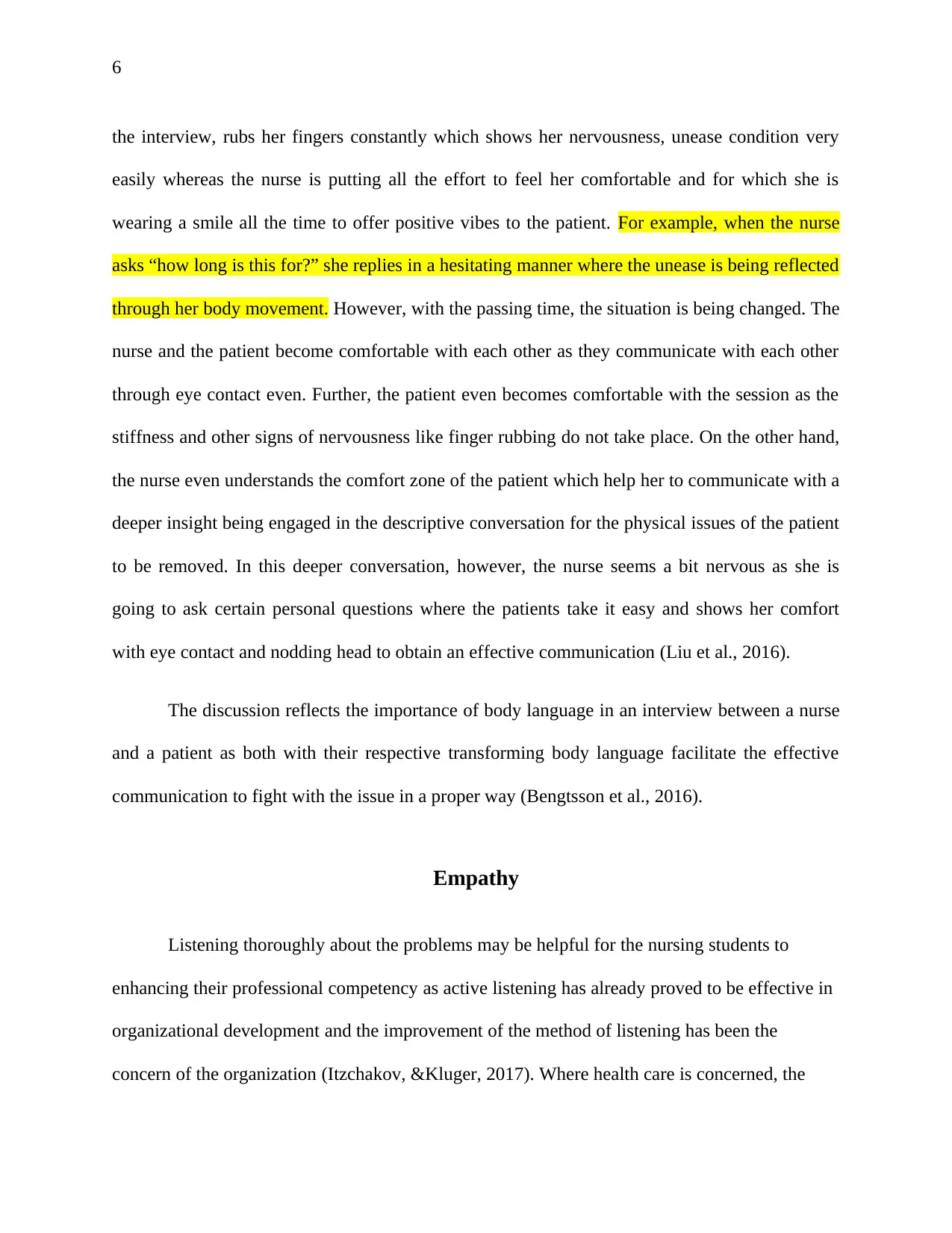
6
the interview, rubs her fingers constantly which shows her nervousness, unease condition very
easily whereas the nurse is putting all the effort to feel her comfortable and for which she is
wearing a smile all the time to offer positive vibes to the patient. For example, when the nurse
asks “how long is this for?” she replies in a hesitating manner where the unease is being reflected
through her body movement. However, with the passing time, the situation is being changed. The
nurse and the patient become comfortable with each other as they communicate with each other
through eye contact even. Further, the patient even becomes comfortable with the session as the
stiffness and other signs of nervousness like finger rubbing do not take place. On the other hand,
the nurse even understands the comfort zone of the patient which help her to communicate with a
deeper insight being engaged in the descriptive conversation for the physical issues of the patient
to be removed. In this deeper conversation, however, the nurse seems a bit nervous as she is
going to ask certain personal questions where the patients take it easy and shows her comfort
with eye contact and nodding head to obtain an effective communication (Liu et al., 2016).
The discussion reflects the importance of body language in an interview between a nurse
and a patient as both with their respective transforming body language facilitate the effective
communication to fight with the issue in a proper way (Bengtsson et al., 2016).
Empathy
Listening thoroughly about the problems may be helpful for the nursing students to
enhancing their professional competency as active listening has already proved to be effective in
organizational development and the improvement of the method of listening has been the
concern of the organization (Itzchakov, &Kluger, 2017). Where health care is concerned, the
the interview, rubs her fingers constantly which shows her nervousness, unease condition very
easily whereas the nurse is putting all the effort to feel her comfortable and for which she is
wearing a smile all the time to offer positive vibes to the patient. For example, when the nurse
asks “how long is this for?” she replies in a hesitating manner where the unease is being reflected
through her body movement. However, with the passing time, the situation is being changed. The
nurse and the patient become comfortable with each other as they communicate with each other
through eye contact even. Further, the patient even becomes comfortable with the session as the
stiffness and other signs of nervousness like finger rubbing do not take place. On the other hand,
the nurse even understands the comfort zone of the patient which help her to communicate with a
deeper insight being engaged in the descriptive conversation for the physical issues of the patient
to be removed. In this deeper conversation, however, the nurse seems a bit nervous as she is
going to ask certain personal questions where the patients take it easy and shows her comfort
with eye contact and nodding head to obtain an effective communication (Liu et al., 2016).
The discussion reflects the importance of body language in an interview between a nurse
and a patient as both with their respective transforming body language facilitate the effective
communication to fight with the issue in a proper way (Bengtsson et al., 2016).
Empathy
Listening thoroughly about the problems may be helpful for the nursing students to
enhancing their professional competency as active listening has already proved to be effective in
organizational development and the improvement of the method of listening has been the
concern of the organization (Itzchakov, &Kluger, 2017). Where health care is concerned, the
⊘ This is a preview!⊘
Do you want full access?
Subscribe today to unlock all pages.

Trusted by 1+ million students worldwide

7
process of conversation requires to be given much preference as the basic step of diagnosis
involves relevant enquiry on the part of the nursing student from the patient (Rørtveit, et al.,
2015). Empathy refers to the ability to place oneself in the situation of another one and thinking
from the perspective of another one (Jeong, 2015) and thus empathy on the part of the nursing
student needs to exist for it will make the future nurse aware of the problem of the patient. The
nurses require to be empathetic in order to become integrated into their daily practice. The
recorded sample of the conversation between the nurse and the patient who has come with some
problem while being analysed will make it clear how much a nursing student needs to be
empathetic towards the patients for providing them with a better quality of health care service.
The example of the question “When did you get married?” can be considered as a piece of a
good example from the interview taken by the nurse. In this particular case the patient is asked
these questions about her personal life which superficially seems to be irrelevant but may be
helpful on the part of the nurse for these questions may enable the nurse to empathically
associate her with the actual problem of the patient for which she has come to be checked up
(Tanioka, 2017). The active listening by the nursing student who is going to be nurse in future
about the problem of the patient will provide her with the ability to resolve the issue quickly by
recommending the patient the exact way of diagnosis for the problem (O’Sullivan, 2017). It can
be recommended that the nurse needs to ask the patients questions as many as possible so that
she can quite easily understand the problems of the patients from the patients’ perspective which
will ultimately be helpful for the patient for they will receive better quality of health care out of
it.
Conclusion
process of conversation requires to be given much preference as the basic step of diagnosis
involves relevant enquiry on the part of the nursing student from the patient (Rørtveit, et al.,
2015). Empathy refers to the ability to place oneself in the situation of another one and thinking
from the perspective of another one (Jeong, 2015) and thus empathy on the part of the nursing
student needs to exist for it will make the future nurse aware of the problem of the patient. The
nurses require to be empathetic in order to become integrated into their daily practice. The
recorded sample of the conversation between the nurse and the patient who has come with some
problem while being analysed will make it clear how much a nursing student needs to be
empathetic towards the patients for providing them with a better quality of health care service.
The example of the question “When did you get married?” can be considered as a piece of a
good example from the interview taken by the nurse. In this particular case the patient is asked
these questions about her personal life which superficially seems to be irrelevant but may be
helpful on the part of the nurse for these questions may enable the nurse to empathically
associate her with the actual problem of the patient for which she has come to be checked up
(Tanioka, 2017). The active listening by the nursing student who is going to be nurse in future
about the problem of the patient will provide her with the ability to resolve the issue quickly by
recommending the patient the exact way of diagnosis for the problem (O’Sullivan, 2017). It can
be recommended that the nurse needs to ask the patients questions as many as possible so that
she can quite easily understand the problems of the patients from the patients’ perspective which
will ultimately be helpful for the patient for they will receive better quality of health care out of
it.
Conclusion
Paraphrase This Document
Need a fresh take? Get an instant paraphrase of this document with our AI Paraphraser
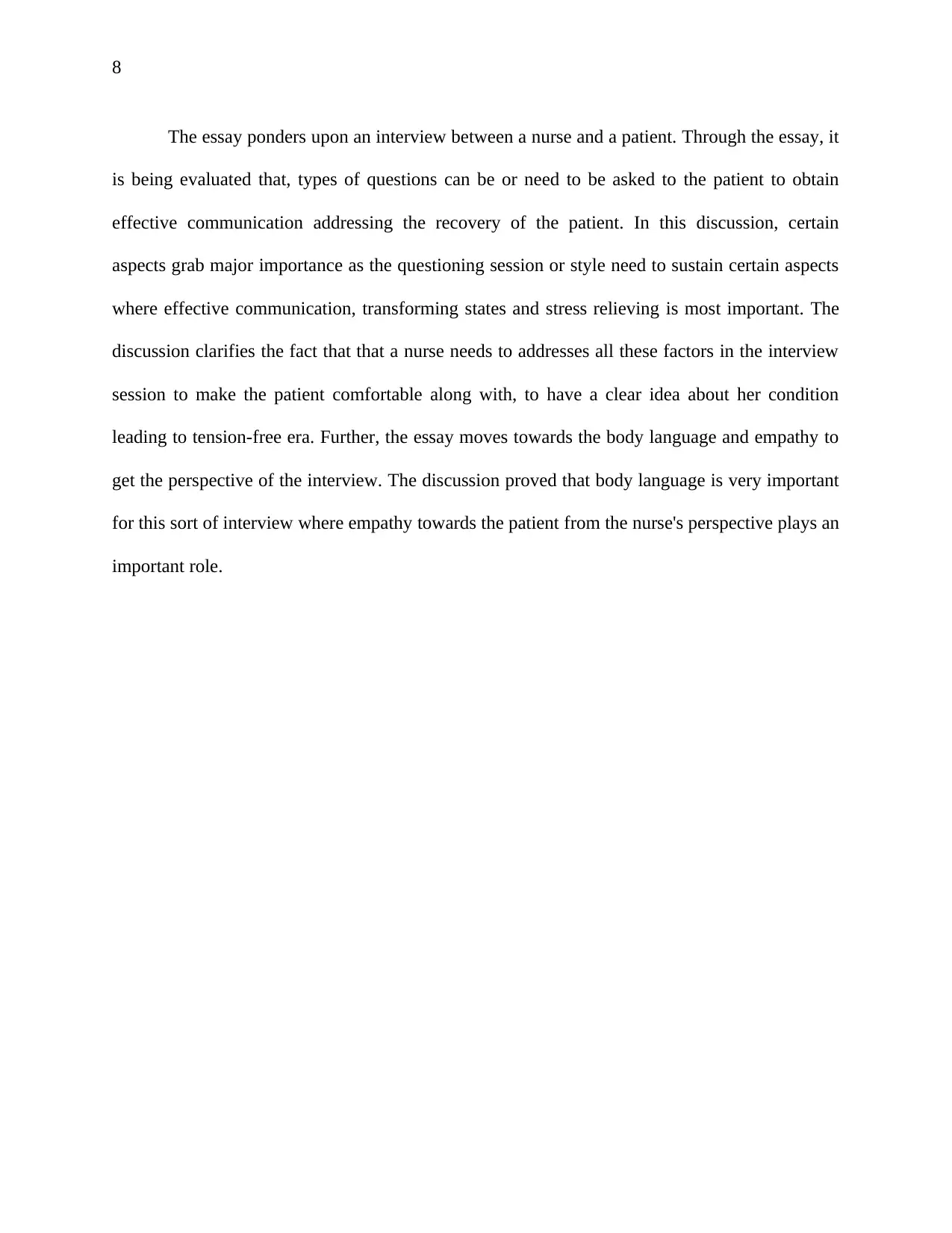
8
The essay ponders upon an interview between a nurse and a patient. Through the essay, it
is being evaluated that, types of questions can be or need to be asked to the patient to obtain
effective communication addressing the recovery of the patient. In this discussion, certain
aspects grab major importance as the questioning session or style need to sustain certain aspects
where effective communication, transforming states and stress relieving is most important. The
discussion clarifies the fact that that a nurse needs to addresses all these factors in the interview
session to make the patient comfortable along with, to have a clear idea about her condition
leading to tension-free era. Further, the essay moves towards the body language and empathy to
get the perspective of the interview. The discussion proved that body language is very important
for this sort of interview where empathy towards the patient from the nurse's perspective plays an
important role.
The essay ponders upon an interview between a nurse and a patient. Through the essay, it
is being evaluated that, types of questions can be or need to be asked to the patient to obtain
effective communication addressing the recovery of the patient. In this discussion, certain
aspects grab major importance as the questioning session or style need to sustain certain aspects
where effective communication, transforming states and stress relieving is most important. The
discussion clarifies the fact that that a nurse needs to addresses all these factors in the interview
session to make the patient comfortable along with, to have a clear idea about her condition
leading to tension-free era. Further, the essay moves towards the body language and empathy to
get the perspective of the interview. The discussion proved that body language is very important
for this sort of interview where empathy towards the patient from the nurse's perspective plays an
important role.

9
References
Bengtsson, Y., Johansson, A., &Englund, E. (2016). Nurse anaesthetists’ experiences of the
first intraoperative meeting with anxious adult patients: An interview study. Nordic
Journal of Nursing Research, 36(3),
148-154.https://www.researchgate.net/profile/Anders_Johansson18/publication/
296567600_Nurse_anaesthetists
%27_experiences_of_the_first_intraoperative_meeting_with_anxious_adult_patients_An
_interview_study/links/59de433fa6fdcca0d3203c0b/Nurse-anaesthetists-experiences-of-
the-first-intraoperative-meeting-with-anxious-adult-patients-An-interview-study.pdf
Dahlkemper, T. (2016). Nursing Leadership, Management, and Professional Practice for the
LPN/LVN, 6e (pp. 25-28).
Itzchakov, G., &Kluger, A. (2017). Can holding a stick improve listening at work? The effect
of Listening Circles on employees’ emotions and cognitions. European Journal Of Work
And Organizational Psychology, 26(5), 663-676. doi: 10.1080/1359432x.2017.1351429
Liu, W., Gerdtz, M., & Manias, E. (2016). Creating opportunities for interdisciplinary
collaboration and patient‐centred care: how nurses, doctors, pharmacists and patients use
communication strategies when managing medications in an acute hospital
setting. Journal of clinical nursing, 25(19-20), 2943-2957.
https://www.researchgate.net/profile/Wei_Liu126/publication/306388138_Creating_oppo
rtunities_for_interdisciplinary_collaboration_and_patient-
centred_care_how_nurses_doctors_pharmacists_and_patients_use_communication_strate
References
Bengtsson, Y., Johansson, A., &Englund, E. (2016). Nurse anaesthetists’ experiences of the
first intraoperative meeting with anxious adult patients: An interview study. Nordic
Journal of Nursing Research, 36(3),
148-154.https://www.researchgate.net/profile/Anders_Johansson18/publication/
296567600_Nurse_anaesthetists
%27_experiences_of_the_first_intraoperative_meeting_with_anxious_adult_patients_An
_interview_study/links/59de433fa6fdcca0d3203c0b/Nurse-anaesthetists-experiences-of-
the-first-intraoperative-meeting-with-anxious-adult-patients-An-interview-study.pdf
Dahlkemper, T. (2016). Nursing Leadership, Management, and Professional Practice for the
LPN/LVN, 6e (pp. 25-28).
Itzchakov, G., &Kluger, A. (2017). Can holding a stick improve listening at work? The effect
of Listening Circles on employees’ emotions and cognitions. European Journal Of Work
And Organizational Psychology, 26(5), 663-676. doi: 10.1080/1359432x.2017.1351429
Liu, W., Gerdtz, M., & Manias, E. (2016). Creating opportunities for interdisciplinary
collaboration and patient‐centred care: how nurses, doctors, pharmacists and patients use
communication strategies when managing medications in an acute hospital
setting. Journal of clinical nursing, 25(19-20), 2943-2957.
https://www.researchgate.net/profile/Wei_Liu126/publication/306388138_Creating_oppo
rtunities_for_interdisciplinary_collaboration_and_patient-
centred_care_how_nurses_doctors_pharmacists_and_patients_use_communication_strate
⊘ This is a preview!⊘
Do you want full access?
Subscribe today to unlock all pages.

Trusted by 1+ million students worldwide

10
gies_when_managing_medications_in_an_acute_hospi/links/
57c31c9108aed246b102a625.pdf
O’Sullivan, D. (2017). Evolution of internal quality assurance at one university – a case
study. Quality Assurance In Education, 25(2), 189-205. doi: 10.1108/qae-03-2016-0011
Rørtveit, K., Hansen, B. S., Leiknes, I., Joa, I., Testad, I., &Severinsson, E. (2015). Patients'
experiences of trust in the patient-nurse relationship-a systematic review of qualitative
studies. https://openarchive.usn.no/usn-xmlui/bitstream/handle/11250/2416907/trust
%2Bpubl.pdf?sequence=3&isAllowed=y
Rydé, K., &Hjelm, K. (2016). How to support patients who are crying in palliative home
care: an interview study from the nurses’ perspective. Primary health care research &
development, 17(5), 479-488.
http://www.diva-portal.org/smash/get/diva2:914563/FULLTEXT01.pdf
Song, H., & Moon, M. (2017). Effects of Critical Thinking Promoting Nursing Process
Education on Critical Thinking Disposition and Problem Solving Ability of Nursing
Students. Korean Association For Learner-Centered Curriculum And Instruction, 17(5),
445-462. doi: 10.22251/jlcci.2017.17.5.445
Suggitt, D. (2015). Appreciative Healthcare Practice: a Guide to Compassionate Person-
Centred Care Roberts GwilymWyn and Machon Andrew Appreciative Healthcare
Practice: a Guide to Compassionate Person-Centred Care 148pp £25 M&K Publishing
9781905539932 1905539932. Nursing Older People, 27(10), 10-10. doi:
10.7748/nop.27.10.10.s8
gies_when_managing_medications_in_an_acute_hospi/links/
57c31c9108aed246b102a625.pdf
O’Sullivan, D. (2017). Evolution of internal quality assurance at one university – a case
study. Quality Assurance In Education, 25(2), 189-205. doi: 10.1108/qae-03-2016-0011
Rørtveit, K., Hansen, B. S., Leiknes, I., Joa, I., Testad, I., &Severinsson, E. (2015). Patients'
experiences of trust in the patient-nurse relationship-a systematic review of qualitative
studies. https://openarchive.usn.no/usn-xmlui/bitstream/handle/11250/2416907/trust
%2Bpubl.pdf?sequence=3&isAllowed=y
Rydé, K., &Hjelm, K. (2016). How to support patients who are crying in palliative home
care: an interview study from the nurses’ perspective. Primary health care research &
development, 17(5), 479-488.
http://www.diva-portal.org/smash/get/diva2:914563/FULLTEXT01.pdf
Song, H., & Moon, M. (2017). Effects of Critical Thinking Promoting Nursing Process
Education on Critical Thinking Disposition and Problem Solving Ability of Nursing
Students. Korean Association For Learner-Centered Curriculum And Instruction, 17(5),
445-462. doi: 10.22251/jlcci.2017.17.5.445
Suggitt, D. (2015). Appreciative Healthcare Practice: a Guide to Compassionate Person-
Centred Care Roberts GwilymWyn and Machon Andrew Appreciative Healthcare
Practice: a Guide to Compassionate Person-Centred Care 148pp £25 M&K Publishing
9781905539932 1905539932. Nursing Older People, 27(10), 10-10. doi:
10.7748/nop.27.10.10.s8
Paraphrase This Document
Need a fresh take? Get an instant paraphrase of this document with our AI Paraphraser

11
Tanioka, T. (2017). The Development of the Transactive Relationship Theory of Nursing
(TRETON): A Nursing Engagement Model for Persons and Humanoid Nursing
Robots. International Journal Of Nursing & Clinical Practices, 4(1). doi:
10.15344/2394-4978/2017/223
Walsh, D., & Bull, R. (2015). Interviewing suspects: examining the association between
skills, questioning, evidence disclosure, and interview outcomes. Psychology, Crime &
Law, 21(7), 661-680. doi: 10.1080/1068316x.2015.1028544
Tanioka, T. (2017). The Development of the Transactive Relationship Theory of Nursing
(TRETON): A Nursing Engagement Model for Persons and Humanoid Nursing
Robots. International Journal Of Nursing & Clinical Practices, 4(1). doi:
10.15344/2394-4978/2017/223
Walsh, D., & Bull, R. (2015). Interviewing suspects: examining the association between
skills, questioning, evidence disclosure, and interview outcomes. Psychology, Crime &
Law, 21(7), 661-680. doi: 10.1080/1068316x.2015.1028544
1 out of 11
Related Documents
Your All-in-One AI-Powered Toolkit for Academic Success.
+13062052269
info@desklib.com
Available 24*7 on WhatsApp / Email
![[object Object]](/_next/static/media/star-bottom.7253800d.svg)
Unlock your academic potential
Copyright © 2020–2025 A2Z Services. All Rights Reserved. Developed and managed by ZUCOL.





